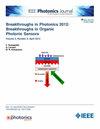Remote Characterization and Dissemination of Disper sion Compensated Ultrashort Pulses Through Dynamic Fiber Optic Links
IF 2.1
4区 工程技术
Q3 ENGINEERING, ELECTRICAL & ELECTRONIC
引用次数: 0
Abstract
Ultrashort optical pulse sources are often complex and resource-intensive, and thus, delivering pulses to multiple satellite locations over a fiber-optic network dynamically from a central location reduces overhead and increases the efficacy of the source usage. For robust delivery, accurate characterization of the pulse dispersion at the satellite locations without specialized equipment and its compensation is essential. This work demonstrates the delivery of dispersion-compensated pulses over standard optical fiber links and their characterization using a simple measurement module at satellite locations. The module uses a second-harmonic crystal and power detectors at the fundamental and second-harmonic wavelengths. A centrally located pulse shaper-based interferometer creates pulse pairs with varying time delays during the characterization phase. Together with the remote detectors, this provides the field and intensity autocorrelations, which describe the spectral and temporal domain of the pulse. We demonstrate our technique by transmitting dispersion compensated sub-400 fs pulses over two fiber optic links of 50 and 100 meters. The pulses are shaped adaptively before transmission to compensate for the dispersion-induced distortions. The pulse intensity and power spectrum are measured remotely and agree with those made at the source. This provides an easy distribution method for femtosecond lasers from central to satellite locations via standard optical fiber links on a time-share basis and their remote characterization.求助全文
约1分钟内获得全文
求助全文
来源期刊

IEEE Photonics Journal
ENGINEERING, ELECTRICAL & ELECTRONIC-OPTICS
CiteScore
4.50
自引率
8.30%
发文量
489
审稿时长
1.4 months
期刊介绍:
Breakthroughs in the generation of light and in its control and utilization have given rise to the field of Photonics, a rapidly expanding area of science and technology with major technological and economic impact. Photonics integrates quantum electronics and optics to accelerate progress in the generation of novel photon sources and in their utilization in emerging applications at the micro and nano scales spanning from the far-infrared/THz to the x-ray region of the electromagnetic spectrum. IEEE Photonics Journal is an online-only journal dedicated to the rapid disclosure of top-quality peer-reviewed research at the forefront of all areas of photonics. Contributions addressing issues ranging from fundamental understanding to emerging technologies and applications are within the scope of the Journal. The Journal includes topics in: Photon sources from far infrared to X-rays, Photonics materials and engineered photonic structures, Integrated optics and optoelectronic, Ultrafast, attosecond, high field and short wavelength photonics, Biophotonics, including DNA photonics, Nanophotonics, Magnetophotonics, Fundamentals of light propagation and interaction; nonlinear effects, Optical data storage, Fiber optics and optical communications devices, systems, and technologies, Micro Opto Electro Mechanical Systems (MOEMS), Microwave photonics, Optical Sensors.
 求助内容:
求助内容: 应助结果提醒方式:
应助结果提醒方式:


